Chapter: Medical Physiology: Introduction to Physiology: The Cell and Its Functions
Cytoplasm and Its Organelles - Physical Structure of the Cell
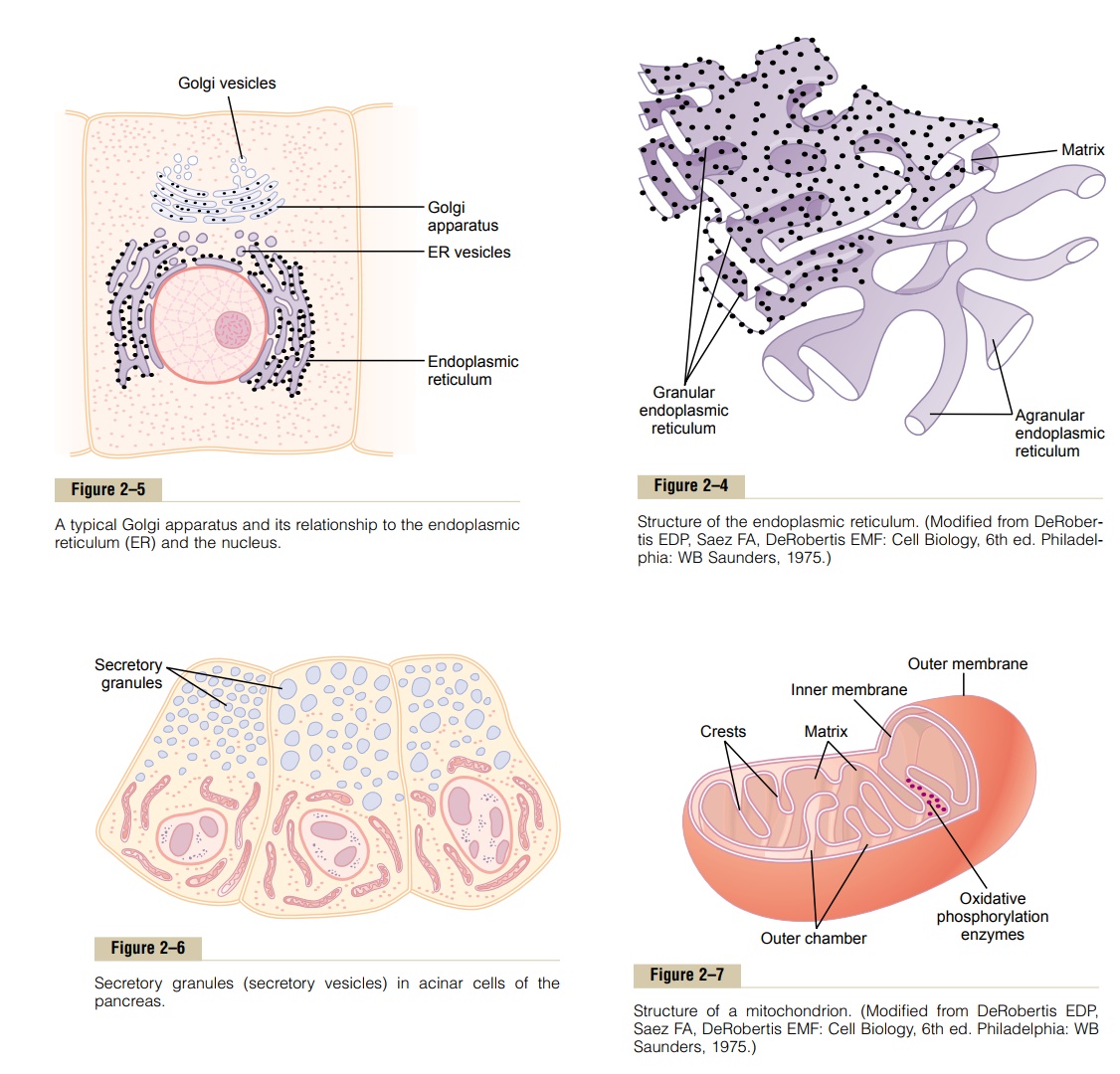
Cytoplasm and Its Organelles
The cytoplasm is filled with both minute and large dis-persed particles and organelles. The clear fluid portion of the cytoplasm in which the particles are dispersed is called cytosol; this contains mainly dissolved pro-teins, electrolytes, and glucose.
Dispersed in the cytoplasm are neutral fat globules, glycogen granules, ribosomes, secretory vesicles, and five especially important organelles: the endoplasmicreticulum, the Golgi apparatus, mitochondria, lyso-somes, and peroxisomes.
Endoplasmic Reticulum
Figure 2–2 shows a network of tubular and flat vesic-ular structures in the cytoplasm; this is the endoplas-mic reticulum. The tubules and vesicles interconnectwith one another. Also, their walls are constructed of lipid bilayer membranes that contain large amounts of proteins, similar to the cell membrane. The total surface area of this structure in some cells—the liver cells, for instance—can be as much as 30 to 40 times the cell membrane area.

The detailed structure of a small portion of endo-plasmic reticulum is shown in Figure 2–4. The space inside the tubules and vesicles is filled with endoplas-mic matrix, a watery medium that is different from thefluid in the cytosol outside the endoplasmic reticulum. Electron micrographs show that the space inside the endoplasmic reticulum is connected with the space between the two membrane surfaces of the nuclear membrane.
Substances formed in some parts of the cell enter the space of the endoplasmic reticulum and are then conducted to other parts of the cell. Also, the vast surface area of this reticulum and the multiple enzyme systems attached to its membranes provide machinery for a major share of the metabolic functions of the cell.
Ribosomes and the Granular Endoplasmic Reticulum.
Attached to the outer surfaces of many parts of the
Where these are present, the reticulum is called the granular endoplas-mic reticulum. The ribosomes are composed of amixture of RNA and proteins, and they function to synthesize new protein molecules in the cell.
Agranular Endoplasmic Reticulum. Part of the endoplasmicreticulum has no attached ribosomes. This part is called the agranular, orsmooth, endoplasmic reticu-lum. The agranular reticulum functions for the syn-thesis of lipid substances and for other processes of the cells promoted by intrareticular enzymes.
Golgi Apparatus
The Golgi apparatus, shown in Figure 2–5, is closely related to the endoplasmic reticulum. It has mem-branes similar to those of the agranular endoplasmic reticulum. It usually is composed of four or more stacked layers of thin, flat, enclosed vesicles lying near one side of the nucleus. This apparatus is prominent in secretory cells, where it is located on the side of the cell from which the secretory substances are extruded.
The Golgi apparatus functions in association with the endoplasmic reticulum. As shown in Figure 2–5, small “transport vesicles” (also called endoplasmic reticulum vesicles, or ER vesicles) continually pinch off from the endoplasmic reticulum and shortly thereafter fuse with the Golgi apparatus. In this way, substances entrapped in the ER vesicles are transported from the endoplasmic reticulum to the Golgi apparatus. The transported substances are then processed in the Golgi apparatus to form lysosomes, secretory vesicles, and other cytoplasmic components.
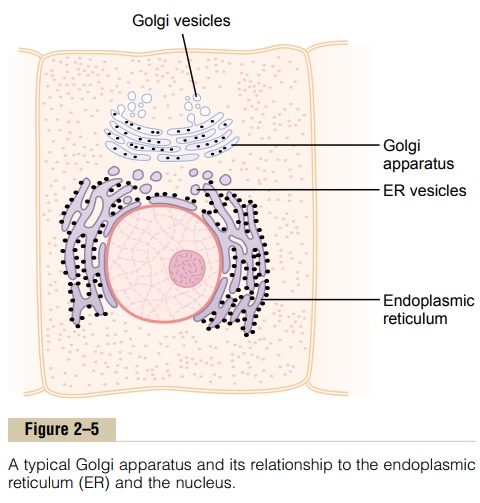
Lysosomes
Lysosomes, shown in Figure 2–2, are vesicular organelles that form by breaking off from the Golgi apparatus and then dispersing throughout the cyto-plasm. The lysosomes provide an intracellular digestivesystem that allows the cell to digest (1) damaged cel-lular structures, (2) food particles that have been ingested by the cell, and (3) unwanted matter such as bacteria. The lysosome is quite different in different types of cells, but it is usually 250 to 750 nanometers in diameter. It is surrounded by a typical lipid bilayer membrane and is filled with large numbers of small granules 5 to 8 nanometers in diameter, which are protein aggregates of as many as 40 different hydro-lase (digestive) enzymes. A hydrolytic enzyme iscapable of splitting an organic compound into two or more parts by combining hydrogen from a water mol-ecule with one part of the compound and combining the hydroxyl portion of the water molecule with the other part of the compound. For instance, protein is hydrolyzed to form amino acids, glycogen is hydrolyzed to form glucose, and lipids are hydrolyzed to form fatty acids and glycerol.
Ordinarily, the membrane surrounding the lysosome prevents the enclosed hydrolytic enzymes from coming in contact with other substances in the cell and, therefore, prevents their digestive actions. However, some conditions of the cell break the membranes of some of the lysosomes, allowing release of the diges-tive enzymes. These enzymes then split the organic substances with which they come in contact into small, highly diffusible substances such as amino acids and glucose.
Peroxisomes
Peroxisomes are similar physically to lysosomes, but they are different in two important ways. First, they are believed to be formed by self-replication (or perhaps by budding off from the smooth endoplasmic reticu-lum) rather than from the Golgi apparatus. Second, they contain oxidases rather than hydrolases. Several of the oxidases are capable of combining oxygen with hydrogen ions derived from different intracellular chemicals to form hydrogen peroxide (H2O2). Hydro-gen peroxide is a highly oxidizing substance and is used in association with catalase, another oxidase enzyme present in large quantities in peroxisomes, to oxidize many substances that might otherwise be poi-sonous to the cell. For instance, about half the alcohol a person drinks is detoxified by the peroxisomes of the liver cells in this manner.
Secretory Vesicles
One of the important functions of many cells is secre-tion of special chemical substances. Almost all such secretory substances are formed by the endoplasmic reticulum–Golgi apparatus system and are then released from the Golgi apparatus into the cytoplasm in the form of storage vesicles called secretory vesicles or secretory granules. Figure 2–6 shows typical secretory vesicles inside pancreatic acinar cells; these
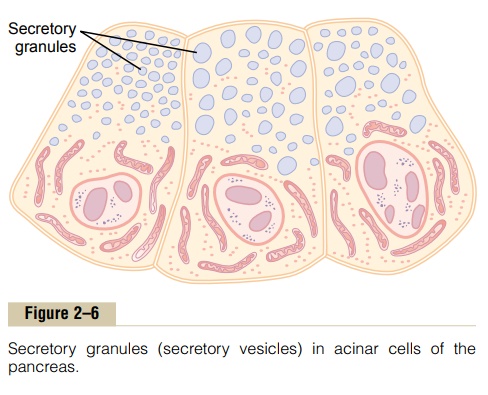
vesicles store protein proenzymes (enzymes that are not yet activated). The proenzymes are secreted later through the outer cell membrane into the pancreatic duct and thence into the duodenum, where they become activated and perform digestive functions on the food in the intestinal tract.
Mitochondria
The mitochondria, shown in Figures 2–2 and 2–7, are called the “powerhouses” of the cell. Without them, cells would be unable to extract enough energy from the nutrients, and essentially all cellular functions would cease.
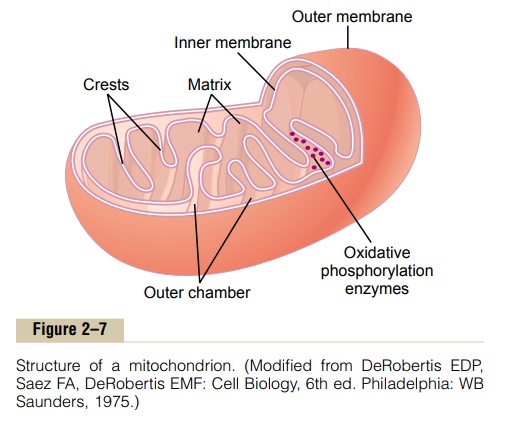
Mitochondria are present in all areas of each cell’s cytoplasm, but the total number per cell varies from less than a hundred up to several thousand, depending on the amount of energy required by the cell. Further, the mitochondria are concentrated in those portions of the cell that are responsible for the major share of its energy metabolism. They are also variable in size and shape. Some are only a few hundred nanometers in diameter and globular in shape, whereas others are elongated—as large as 1 micrometer in diameter and 7 micrometers long; still others are branching and filamentous.
The basic structure of the mitochondrion, shown in Figure 2–7, is composed mainly of two lipid bilayer–protein membranes: an outer membrane and an inner membrane. Many infoldings of the inner membrane form shelves onto which oxidative enzymes are attached. In addition, the inner cavity of the mito-chondrion is filled with a matrix that contains large quantities of dissolved enzymes that are necessary for extracting energy from nutrients. These enzymes operate in association with the oxidative enzymes on the shelves to cause oxidation of the nutrients, thereby forming carbon dioxide and water and at the same time releasing energy. The liberated energy is used to synthesize a “high-energy” substance called adenosinetriphosphate (ATP). ATP is then transported out of themitochondrion, and it diffuses throughout the cell to release its own energy wherever it is needed for per-forming cellular functions.
Mitochondria are self-replicative, which means that one mitochondrion can form a second one, a third one, and so on, whenever there is a need in the cell for increased amounts of ATP. Indeed, the mitochondria contain DNA similar to that found in the cell nucleus. We will see that DNA is the basic chem-ical of the nucleus that controls replication of the cell. The DNA of the mitochondrion plays a similar role, controlling replication of the mitochondrion itself.
Filament and Tubular Structures of the Cell
The fibrillar proteins of the cell are usually organized into filaments or tubules. These originate as precursor protein molecules synthesized by ribosomes in the cytoplasm. The precursor molecules then polymerize to form filaments. As an example, large numbers of actin filaments frequently occur in the outer zone of the cytoplasm, called the ectoplasm, to form an elastic support for the cell membrane. Also, in muscle cells, actin and myosin filaments are organized into a special contractile machine that is the basis for muscle con-traction.
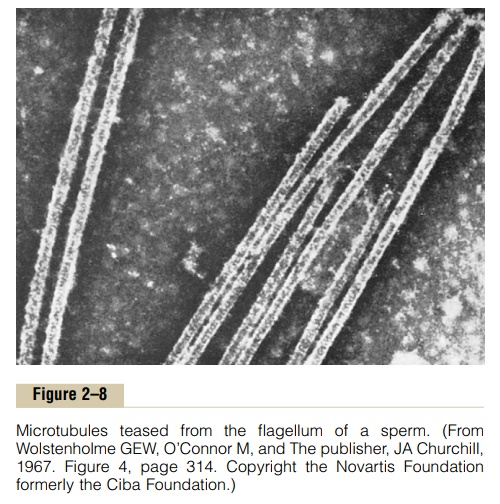
A special type of stiff filament composed of poly-merized tubulin molecules is used in all cells to con-struct very strong tubular structures, the microtubules. Figure 2–8 shows typical microtubules that were teased from the flagellum of a sperm.
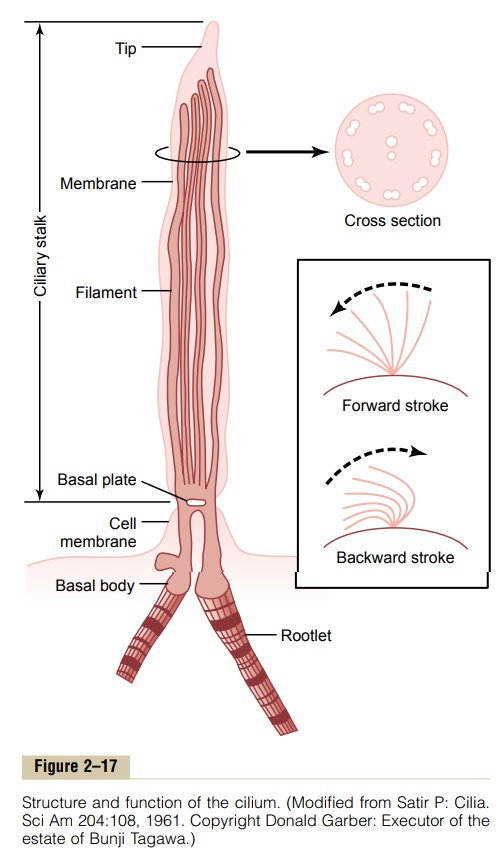
Another example of microtubules is the tubular skeletal structure in the center of each cilium that radi-ates upward from the cell cytoplasm to the tip of the cilium. This structure is discussed later and is illustrated in Figure 2–17. Also, both the centri-oles and themitotic spindle of the mitosing cell arecomposed of stiff microtubules.
Thus, a primary function of microtubules is to act as a cytoskeleton, providing rigid physical structures for certain parts of cells.
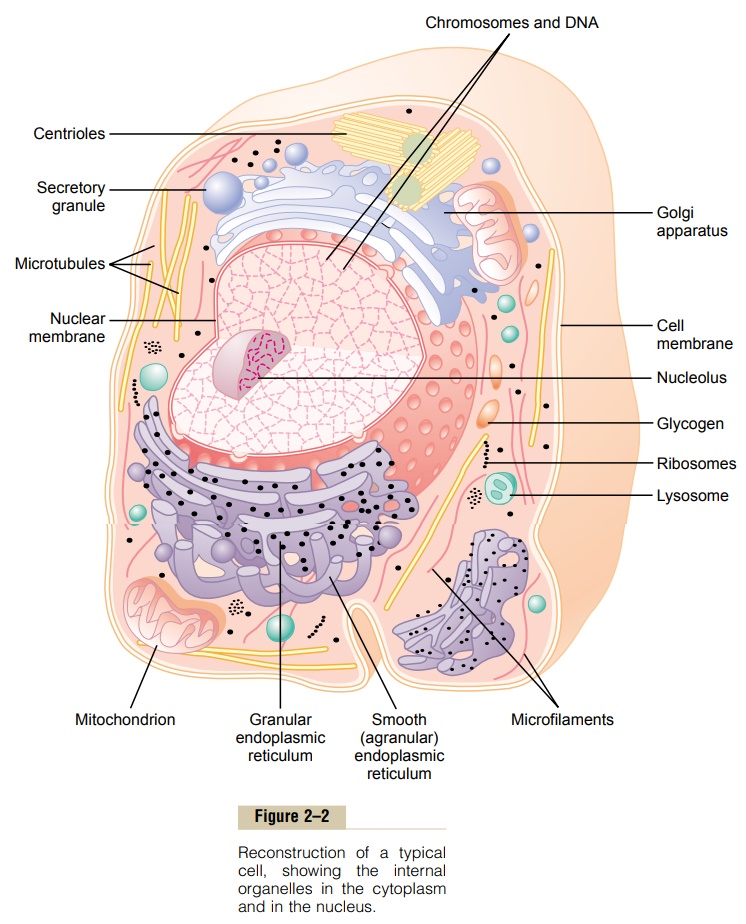
Related Topics